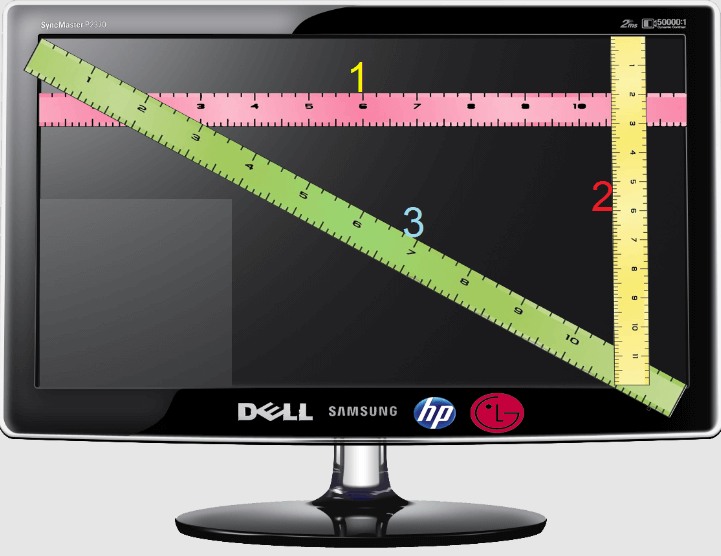
It’s crucial to acknowledge the significant impact that computer monitors have on our daily activities, whether it’s for work, gaming, or casual browsing. Understanding how to measure and interpret monitor specifications can greatly affect your choice in finding the perfect one to meet your needs. How do you measure a computer monitor This ensures that you receive optimal performance and comfort. In this blog post, we will thoroughly explore the various aspects of monitor measurements, including diagonal size, resolution, aspect ratio, and ergonomic features. Let’s make sure you are well-informed and prepared to make the best monitor choice for your requirements!
Table of Contents
1. Understanding Monitor Sizes
Diagonal Measurement
When it comes to purchasing a computer monitor, size absolutely matters. The larger the monitor, the more immersive and enjoyable your viewing experience will be. Whether you prefer a 24-inch, 27-inch, or 32-inch monitor, there’s a size that will cater to your specific needs and preferences. So why settle for a smaller screen when you can go big and truly enjoy your computer usage? Make the upgrade to a larger monitor and see the difference for yourself!

Aspect Ratio–How do you measure a computer monitor
When it comes to choosing a monitor, the aspect ratio is a crucial factor that should not be overlooked. It determines the proportional relationship between the width and height of the screen, and this has a direct impact on the user experience. There are various options available, such as 16:9 widescreen, 4:3 standard, and 21:9 ultrawide, and it’s important to select the aspect ratio that best suits your needs. Widescreen and ultrawide monitors offer more horizontal space, making them perfect for multitasking and providing an immersive viewing experience. It’s essential to understand the significance of aspect ratio when making your monitor choice. Don’t underestimate its impact!
2. Resolution
Pixels and Resolution
Resolution is absolutely crucial when it comes to the quality of display. The more pixels there are, the sharper and clearer the images will be. Common resolutions like Full HD, 1440p, and 4K are widely used for tasks that demand detailed visuals, such as graphic design and video editing. So, it’s absolutely essential to consider the resolution when choosing a display for your work or entertainment needs. Don’t settle for anything less than the best resolution for your viewing experience!
Pixel Density (PPI)
When it comes to choosing a monitor, pixel density is absolutely crucial. The higher the pixel density, the better the detail and clarity of the screen. Just imagine the difference between a 27-inch monitor with 4K resolution and one with Full HD resolution – the 4K monitor will give you much crisper images and text. If you want the best visual experience, it’s worth investing in a monitor with higher PPI. Trust me, you won’t regret it!
3. Screen Dimensions and Usability
Width and Height
When you’re in the market for a new monitor, it’s essential to look beyond just the diagonal measurement. Consider the physical width and height of the screen as well. These dimensions play a critical role and are influenced by factors like the diagonal size and aspect ratio. For instance, a 24-inch monitor with a 16:9 aspect ratio will have different width and height measurements compared to a 24-inch monitor with a 21:9 aspect ratio. So, don’t just fixate on the diagonal size; take into account the overall dimensions for the ultimate viewing experience. Trust me, it makes all the difference!
Bezel and Screen-to-Body Ratio
When searching for a monitor, it’s crucial to take into account the thickness of the bezel. Thin bezels not only contribute to a modern and chic appearance, but they also increase the screen-to-body ratio, allowing for a more expansive and immersive viewing experience. This means more visible screen area for enhanced enjoyment. Therefore, it’s essential to prioritize a thin bezel when selecting a monitor to maximize your visual pleasure.
4. Different Types of Monitors
Standard Monitors
Standard monitors are an absolute must-have for any workspace. They offer versatility and functionality for a wide range of tasks, whether it’s working on office projects, browsing the web, or enjoying some casual gaming. Plus, with their various sizes and resolutions, you can easily find one that suits your specific needs. And let’s not forget about their widespread availability and affordability, making them the go-to choice for everyday use. Trust me, you can’t go wrong with a standard monitor!
Ultrawide and Curved Monitors
Ultrawide and curved monitors offer a whole new level of visual experience that simply can’t be matched by traditional monitors. The wider aspect ratio and increased horizontal space are perfect for multitasking and immersive gaming. And let’s not forget about the curved monitors, which provide a more natural viewing experience, reducing eye strain and enhancing immersion.
Both of these options offer unique benefits that can greatly enhance your overall computing and gaming experience. So why not consider them for your next monitor upgrade? It’s time to step up your monitor game and take full advantage of the incredible visual capabilities that ultrawide and curved monitors have to offer.
Portable Monitors
Portable monitors are an absolute game-changer for anyone who is constantly on the move. These lightweight and compact screens are specifically designed for on-the-go use, allowing you to easily extend your screen space while traveling or working remotely. With easy connectivity through USB or HDMI, portable monitors offer unmatched convenience and versatility for those who need to stay productive while away from their traditional workstation. Don’t miss out on the amazing benefits of portable monitors for your on-the-go lifestyle.
5. Measuring for Ergonomics and Setup
Desk Space and Monitor Placement
When it comes to choosing a monitor, it’s crucial to consider the amount of desk space you have and where you plan to place it. You definitely don’t want a monitor that takes up too much space and adds to the clutter on your desk. It’s also important to prioritize ergonomic comfort and reduce strain by positioning the monitor at eye level and at arm’s length away. Therefore, it’s essential to select a monitor that fits your workspace and promotes a comfortable and healthy work environment.
Height Adjustability and VESA Mounting
You absolutely need height-adjustable stands and VESA mounts for your monitor. They give you the power to customize your viewing angle and create a workspace that is tailored to your specific needs and preferences. With these features, you can achieve better ergonomics, free up valuable desk space, and even mount your monitor on a wall or arm. Don’t miss out on the opportunity to create the perfect workspace for yourself.
6. Industry Standards and Future Trends
Current Industry Standards
In today’s fast-paced industry, monitors have evolved to meet a wide range of needs. From basic office tasks to high-end gaming and professional design work, monitors now come with specifications like resolution, refresh rate, and color accuracy to ensure optimal performance. These industry standards ensure that users have the right tools for their specific tasks, making it easier to get work done efficiently and effectively. It’s important to have the best monitor for your needs in order to excel in your work and stay ahead of the competition.
Emerging Trends
The latest advancements in monitor technology are absolutely revolutionary. With higher resolutions like 8K, faster refresh rates, and advancements in OLED and Mini-LED displays, the future of visual display is brighter than ever. These innovations are not just about better performance and improved visuals, they are about creating more immersive experiences for users. It’s time to embrace the future of monitor technology and elevate our visual experiences to a whole new level.
Conclusion
When it comes to buying a computer monitor, it’s crucial to understand how they are measured. Factors such as diagonal size, resolution, aspect ratio, and ergonomics all play a vital role in determining the right monitor for your needs. Take the time to assess your requirements and choose a monitor that not only enhances your productivity but also adds to your overall enjoyment. Making an informed purchase will ensure that you get the most out of your monitor. So, make sure you do your research and invest in a monitor that will truly meet your needs.
Also read best monitors for watching movies
FAQs
Q1: How do I measure my current monitor size?
When it comes to gaming, the resolution you choose can make a huge difference in your visual experience. While Full HD (1080p) is a popular choice for many gamers, if your hardware can handle it, upgrading to 1440p or even 4K will give you stunning visuals that truly enhance your gaming experience. Don’t settle for standard resolution when you have the capability to take your gaming to the next level with higher resolution options. Your hardware is capable of delivering top-notch visuals, so why not take advantage of it?
Q2: What is the best resolution for gaming?
When it comes to gaming, it’s crucial to consider the resolution that best suits your hardware. Sure, Full HD (1080p) is a popular choice, but if your graphics card can handle it, why not go for 1440p or 4K resolution? Upgrading to a higher resolution can truly elevate your gaming experience with breathtaking visuals. It’s all about pushing the limits of your hardware to maximize your gaming enjoyment. Don’t settle for less when you could be experiencing the best that your system has to offer.
Q3: Are curved monitors better than flat monitors?
Curved monitors provide a truly immersive viewing experience and can even help reduce eye strain. However, the decision between a curved or flat monitor ultimately depends on your personal preference and how you plan to use it. It’s important to carefully consider your specific needs and preferences before making a decision. So, think about how you will be using your monitor and what features are most important to you. Your viewing experience should be tailored to your individual needs, so choose wisely!
Q4: What is the difference between 16:9 and 21:9 aspect ratios?
When it comes to screen aspect ratios, the 16:9 standard widescreen is good for everyday tasks. But if you want even more horizontal space and a truly immersive experience for multitasking and gaming, the 21:9 ultrawide aspect ratio is the way to go. Upgrade to an ultrawide screen and take your productivity and gaming to the next level. Trust me, you won’t regret it.
Q5: How important is pixel density?
When choosing a display, it’s crucial to consider the pixel density (PPI). Opting for a higher PPI means enjoying better sharpness and clarity, which is absolutely essential for tasks that demand detailed visuals like graphic design. Don’t settle for a lower PPI when you can have the best quality display for your work. Choose wisely and prioritize the visual quality that will elevate your work.
Author’s Bio
Sarah is a tech enthusiast with a passion for exploring the latest advancements in computer hardware and display technologies. With years of experience in the industry, Sarah has gained valuable insights into the intricacies of monitor measurements and specifications. Through his informative articles and blog posts, he aims to educate readers on how to make informed decisions when selecting the perfect monitor for their needs. Sarah expertise lies in simplifying complex technical concepts and presenting them in an accessible manner for readers of all levels.



